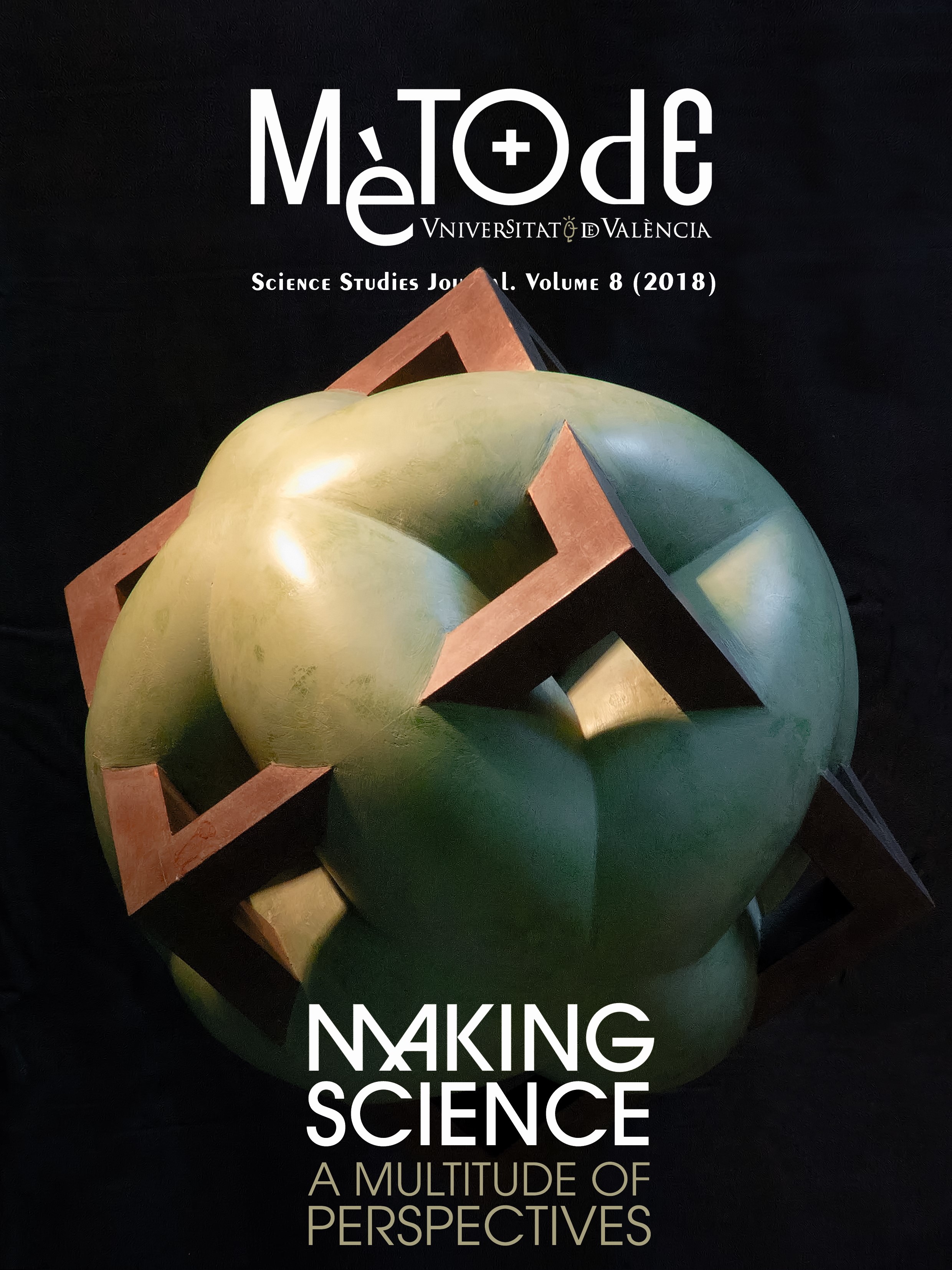L’eixida d’Àfrica: Un escenari alternatiu per a la primera dispersió humana a Euràsia
DOI:
https://doi.org/10.7203/metode.8.10171Paraules clau:
eixida d’Àfrica, Dmanisi, Homo arcaic, felí de dents de sabre, plistocè inferior, paleoclimatologia Resum
Resum
Les proves paleoantropològiques trobades en el jaciment del plistocè primerenc de Dmanisi (Geòrgia) han revelat que els primers hominins que van eixir d’Àfrica eren més arcaics que les poblacions africanes i asiàtiques coetànies Homo erectus. Hi ha evidències que suggereixen que aquests hominins habitaven els boscos en compte de viure a la sabana. Fa entre 1,8 i 1,6 milions d’anys una crisi climàtica va provocar l’expansió de la sabana i altres zones àrides per gran part d’Àfrica. Com a conseqüència, les primeres poblacions d’Homo es van dividir; algunes es van adaptar a les noves condicions ecològiques i d’altres van seguir les zones boscoses en recessió.
 Descàrregues
Descàrregues
 Referències
Referències
Agustí, J., & Antón, M. (2002). Mammoths, sabertooths, and hominids. New York: Columbia University Press.
Agustí, J., & Lordkipanidze, D. (2011). How «African» was the early human dispersal out of Africa? Quaternary Science Review, 30(11–12), 1338–1342. doi: 10.1016/j.quascirev.2010.04.012
Arribas, A., & Palmqvist, P. (1999). On the ecological connection between sabre-tooths and hominids: Faunal dispersal events in the Lower Pleistocene and a review of the evidence for the first human arrival in Europe. Journal of Archaeological Science, 26, 571–585. doi: 10.1006/jasc.1998.0346
Blumenschine, R. J. (1988). An experimental model of the timing of hominid and carnivore influence on archaeological bone assemblages. Journal of Archaeological Science, 15, 483–502. doi: 10.1016/0305-4403(88)90078-7
Blumenschine, R. J., & Marean, C. W. (1993). A carnivore’s view of archaeological bone assemblages. In J. Hudson (Ed.), From bones to behaviour: Ethnoarchaeological and experimental contributions to the interpretation of faunal remains (pp. 273–300). Carbondale: University of southern Illinois.
Carbonell, E., Mosquera, M., Rodríguez, X. P., Sala, R., & Van der Made, J. (1999). Out of Africa: The dispersal of the earliest technical systems reconsidered. Journal of Anthropological Archeology, 18(2), 119–136. doi: 10.1006/jaar.1998.0331
Dennell, R. (2009). The Palaeolithic settlement of Asia. Cambridge: Cambridge University Press.
Domínguez-Rodrigo, M. (2001). A study of carnivore competition in riparian and open habitats of modern savannas and its implications for hominid behavioral modelling. Journal of Human Evolution, 40, 77–98. doi: 10.1006/jhev.2000.0441
Horowitz, A. (1989). Continuous pollen diagrams for the last 3.5 m.y. from Israel: Vegetation, climate and correlation with the oxygen isotope record. Palaeogeography, Palaeoclimatology, Palaeoecology, 72, 63–78. doi: 10.1016/0031-0182(89)90132-6
Lordkipanidze, D., Jashashvili, T., Vekua, A., De León, M. S. P., Zollikofer, C. P. E., Rightmire, G. P., … Rook, L. (2007). Postcranial evidence from early Homo from Dmanisi, Georgia. Nature, 449, 305–310. doi: 10.1038/nature06134
Lordkipanidze, D., Ponce de León, M., Margvelashvili, A., Rak, Y., Rightmire, G. P., Vekua, A., & Zollikofer, C. P. E. (2013). A complete skull of early Homo from Dmanisi, Georgia, and its implications for the evolution and population biology of the genus Homo. Science, 342(6156), 326–331. doi: 10.1126/science.1238484
Marean, C. W. (1989). Sabertooth cats and their relevance for early hominid diet and evolution. Journal of Human Evolution, 18(6), 559–582. doi: 10.1016/0047-2484(89)90018-3
Marean, C. W., & Erhardt, C. L. (1995). Paleoanthropological and paleoecological implications of the taphonomy of a sabertooth’s den. Journal of Human Evolution, 29(6), 515–547. doi: 10.1006/jhev.1995.1074
Martínez-Navarro, B., & Palmqvist, P. (1995). Presence of the African Machairodont Megantereon whitei (Broom, 1937) (Felidae, Carnivora, Mammalia) in the Lower Pleistocene of Venta Micena (Orce, Granada, Spain), with some considerations on the origin, evolution and dispersal of the genus. Journal of Archaeological Science, 22, 569–582. doi: 10.1006/jasc.1994.0054
Shatilova, I., Mchedlishvil, N., Rukhadze, L., & Kvavadze, E. (2011). The history of the flora and vegetation of Georgia (South Caucasus). Tbilisi: Institute of Paleobiology. Georgian National Museum.
Tappen, M., Lordkipanidze, D., Bukshianidze, M., & Ferring, R. (2007). Are you in or out (of Africa?). In T. R. Pickering, K. Schick, & N. Toth (Eds.), Breathing life into fossils: Taphonomic studies in honor of C. K. Brain(pp. 119–135). Bloomington, IN: Stone Age Institute Press.
Tchernov, E. (1992). The Afro-Arabian component in the Levantine mammalian fauna: A short biogeographical review. Israel Journal of Zoology, 38, 155–192.
Vekua, A., Lordkipanidze, D., Rightmire, G.P., Agustí, J., Ferring, R., Maisuradze, G., Mouskhelishvili, A., … Zollikofer, C. (2002). A new skull of early Homo from Dmanisi, Georgia. Science, 297, 85–89. doi: 10.1126/science.1072953
Descàrregues
Publicades
Com citar
-
Resum2191
-
PDF 957
Número
Secció
Llicència
![]()
Tots els documents inclosos en OJS són d'accés lliure i propietat dels seus autors.
Els autors que publiquen en aquesta revista estan d'acord amb els següents termes:
- Els autors conserven els drets d'autor i garanteixen a la revista el dret a la primera publicació del treball, llicenciat baix una llicència de Reconeixement-NoComercial-SenseObraDerivada 4.0 Internacional de Creative Commons, que permet a altres compartir el treball amb un reconeixement de l'autoria del treball i citant la publicació inicial en aquesta revista.
- Es permet i s'anima els autors a difondre la versió definitiva dels seus treballs electrònicament a través de pàgines personals i institucionals (repositoris institucionals, pàgines web personals o perfils a xarxes professionals o acadèmiques) una vegada publicat el treball.





